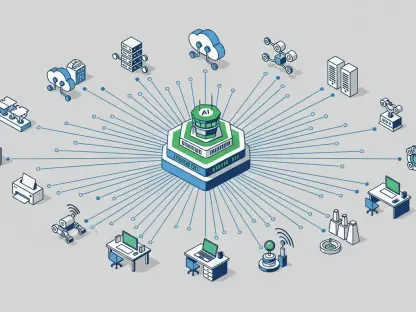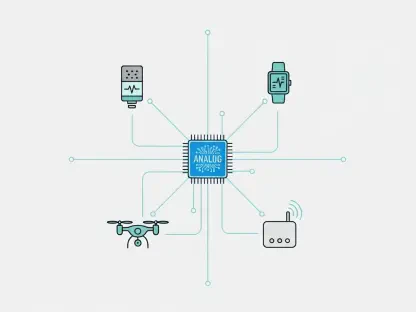Laurent Giraid is a technologist with a finely honed expertise in Artificial Intelligence, particularly in the realms of machine learning, natural language processing, and AI ethics. With an extensive background in high-performance computing and AI applications, Laurent offers valuable insights into the recent advancements at the University of Edinburgh. This interview aims to delve into the significance of the new AI cluster installation at the Edinburgh Parallel Computing Centre (EPCC) and its broader implications for the AI research community.
Can you explain the significance of the recent installation of the AI cluster consisting of four CS-3s at the University of Edinburgh?
This installation is incredibly significant for several reasons. The CS-3 systems represent the latest in AI computing technology, offering unprecedented processing power and scalability. Compared to the previous CS-1 and CS-2 systems, the CS-3s can handle much larger AI models with greater efficiency. This means that the Edinburgh Parallel Computing Centre (EPCC) will now have enhanced capabilities to push the boundaries of AI research and development.
What are CS-3 systems and how do they compare to previous CS-1 and CS-2 systems?
The CS-3 systems are built on Cerebras’s third generation of Wafer Scale Engine processors, which offer massive computational power packed into a single wafer-scale chip. This creates a highly efficient and powerful platform that can scale linearly. Compared to the earlier CS-1 and CS-2 systems, the CS-3s offer more cores, better performance, and the ability to train much larger models, making them a more versatile tool for advanced AI research.
How does this installation enhance the capabilities of the Edinburgh Parallel Computing Centre (EPCC)?
The installation of the CS-3 cluster significantly enhances EPCC’s capabilities by providing the raw computational power needed for training massive AI models, including those with up to 240 billion parameters, which can be extended to 1 trillion. This not only accelerates the speed of training models but also allows for more complex and advanced research to be conducted, propelling EPCC to the forefront of AI research.
What is the role of the Edinburgh International Data Facility in this new AI cluster installation?
The Edinburgh International Data Facility is critical in this context as it hosts the infrastructure required to support such a powerful AI cluster. It integrates vast amounts of data from various sources, making it accessible for AI-driven research and projects. This facility, through its comprehensive data services, forms the backbone of the university’s Data Driven Innovation program.
How does this facility contribute to the university’s Data Driven Innovation program?
The facility plays a pivotal role in the Data Driven Innovation program by providing the infrastructure and support needed to harness large datasets for AI and other data-intensive projects. It empowers researchers with the tools and data they require to drive innovation in various fields, such as healthcare, environmental science, and engineering, benefiting the Edinburgh and South East Scotland City Region.
The new CS-3 cluster can train models of up to 240 billion parameters and can be extended to 1 trillion. What types of AI models can be trained using this cluster?
With such extensive capabilities, the CS-3 cluster can train a wide variety of sophisticated AI models, including large language models (LLMs), image recognition systems, and complex simulations. These models are essential for breakthroughs in natural language processing, computer vision, and other AI domains, significantly pushing the boundaries of what’s currently possible in AI research.
How does this capability impact the research and development of AI at EPCC?
This capability positions EPCC as a global leader in AI research. By enabling the training of incredibly large and complex models, researchers can explore new algorithms and methodologies that were previously infeasible due to computational limitations. This capability will undoubtedly foster innovation and lead to significant advancements in AI.
EPCC mentioned the ‘ease of use’ of Cerebras’s technology. How does Cerebras’s technology facilitate a more democratic approach to AI model development?
Cerebras’s technology is designed to be user-friendly and accessible to a broad range of researchers, not just those with extensive backgrounds in computer science. The ease of use means that scientists from various disciplines can begin building and training models without needing to master complex parallel programming, thus lowering the barrier to entry and fostering a more inclusive environment for AI model development.
What makes Cerebras’s technology unique in terms of scalability and predictability?
What sets Cerebras apart is its ability to scale linearly, which provides unmatched predictability in training efforts. This linear scalability means that doubling the hardware results in a near-doubling of performance, making it simpler to anticipate the computational resources required for increasingly complex models. This predictability is a significant advantage for planning and executing AI research projects.
Can you discuss some successful applications of CS-2 systems at EPCC?
Several notable applications have emerged from the use of CS-2 systems at EPCC. They’ve been instrumental in developing large-scale models for biomedical research and natural language processing. For example, local company smartR AI successfully fine-tuned LLMs using the CS-2, while international researchers developed models for materials science and linguistic support for Swiss German dialects, showcasing the versatile application of these systems in diverse fields.
How have these systems contributed to biomedical AI research and the development of LLMs?
The CS-2 systems have considerably advanced both biomedical AI research and the development of large language models. These systems enable the training of models that can process and analyze complex biomedical data, leading to new insights and potentially groundbreaking treatments. Similarly, for LLMs, the computational power allows for the development of more sophisticated, accurate, and capable language models, benefiting numerous applications from healthcare to linguistics.
The CS-3 cluster includes 3.6 million AI compute cores. What research areas at EPCC will benefit the most from this computational power?
The sheer computational power provided by 3.6 million AI compute cores will benefit a wide range of research areas. High-performance computing projects involving simulations, AI for healthcare, environmental modeling, and data analytics are some of the fields that will see significant advancements. The ability to run complex simulations and process vast datasets at higher speeds will greatly enhance research quality and outcomes.
How will this investment influence research into parallelism and energy efficiency?
This investment acts as a catalyst for research into optimizing parallelism and improving energy efficiency. By providing unprecedented computing power, researchers can explore new parallel algorithms and techniques that make better use of available resources. Additionally, energy efficiency is a critical area of focus, aimed at reducing the carbon footprint of large-scale AI computations, making sustainable AI a more attainable goal.
What impact does this investment in AI technology have on universities, public sector organizations, and companies in the region?
The investment in AI technology creates a ripple effect that benefits universities, public sector organizations, and companies in the region. For universities, it enhances research capabilities and attracts top-tier talent. Public sector organizations can leverage advanced AI tools for smarter decision-making and resource management. Companies, both large and small, gain access to cutting-edge technology, enabling them to innovate and stay competitive in a rapidly evolving market.
How will this help train and use AI models more efficiently?
The advanced capabilities of the CS-3 cluster streamline the training and utilization of AI models, making them more efficient and less time-consuming. This efficiency translates to faster iterations, reduced training times, and the ability to undertake more ambitious projects. Ultimately, this means researchers and practitioners can develop and deploy AI solutions more rapidly, accelerating the pace of innovation.
What potential advancements in AI research does EPCC anticipate as a result of this investment?
EPCC anticipates several potential advancements following this investment, including the development of more sophisticated and capable AI models, breakthroughs in machine learning algorithms, and enhanced applications across various industries. This investment will also likely lead to new discoveries in AI-powered data analysis, significantly impacting fields such as medicine, environmental science, and beyond.
How has EPCC’s collaboration with Cerebras evolved since it began in 2020?
Since the collaboration began in 2020, EPCC’s partnership with Cerebras has grown stronger, with both parties working closely to push the boundaries of AI research. Initially focusing on training AI models at scale, the collaboration has evolved to include advancements in AI inference technology. This ongoing partnership has been instrumental in ensuring EPCC remains at the cutting edge of AI research.
Do you have any advice for our readers?
My advice is to stay curious and keep learning. The field of AI is rapidly evolving, and it’s essential to stay informed about the latest advancements and technologies. Whether you’re a researcher, a student, or a professional, embracing a mindset of continuous learning will equip you to navigate and contribute to this exciting and dynamic field.









